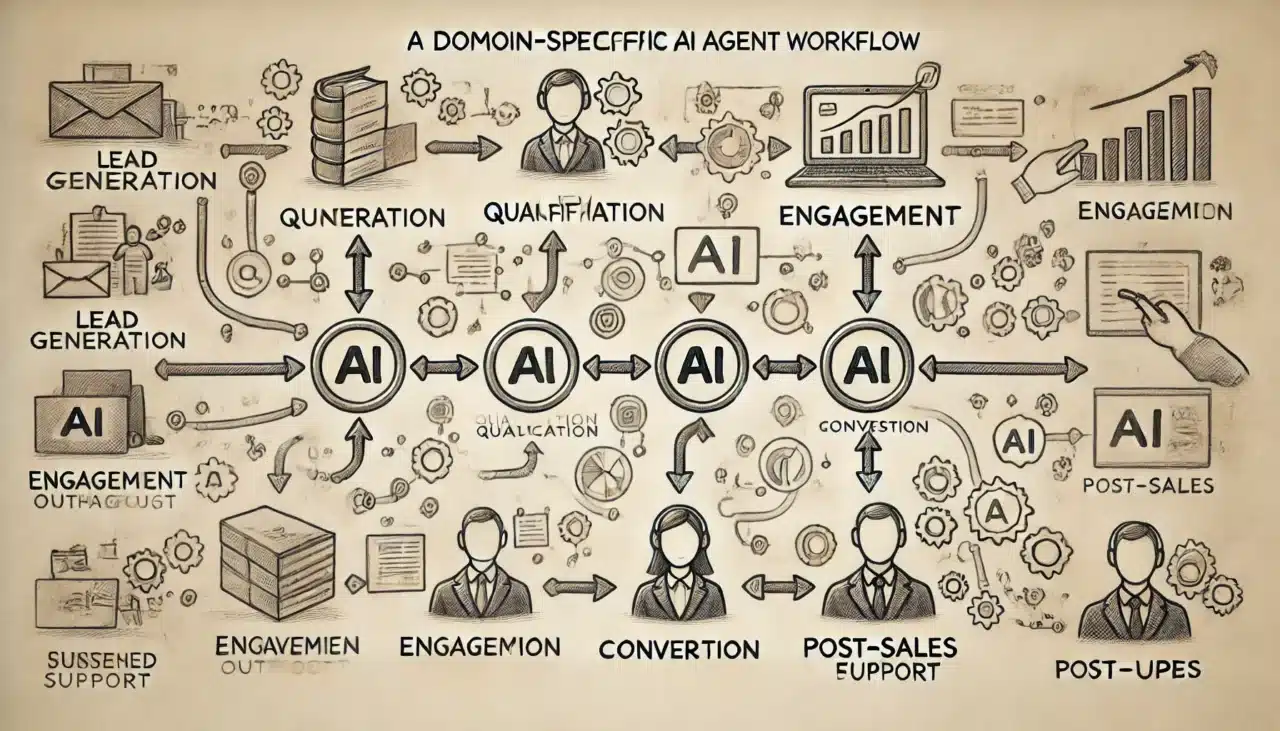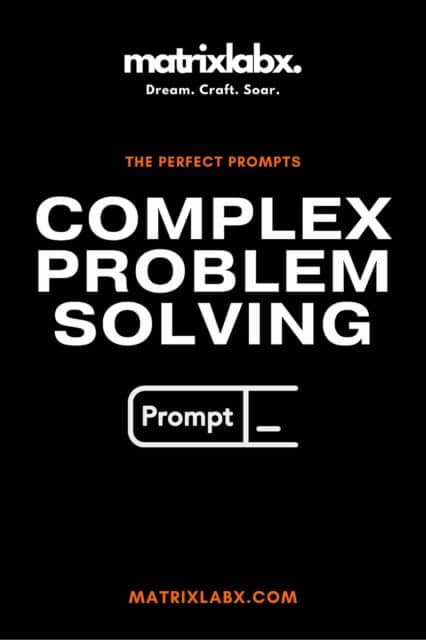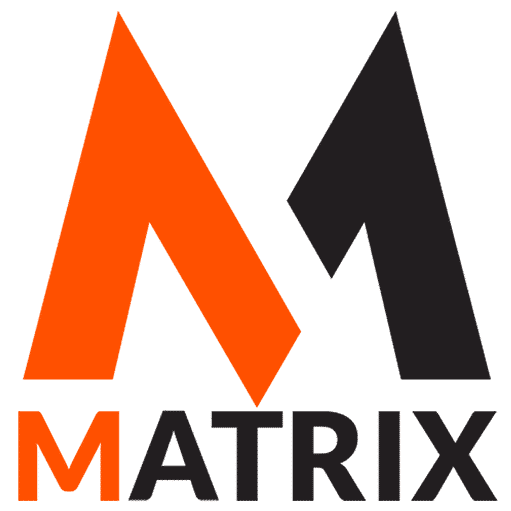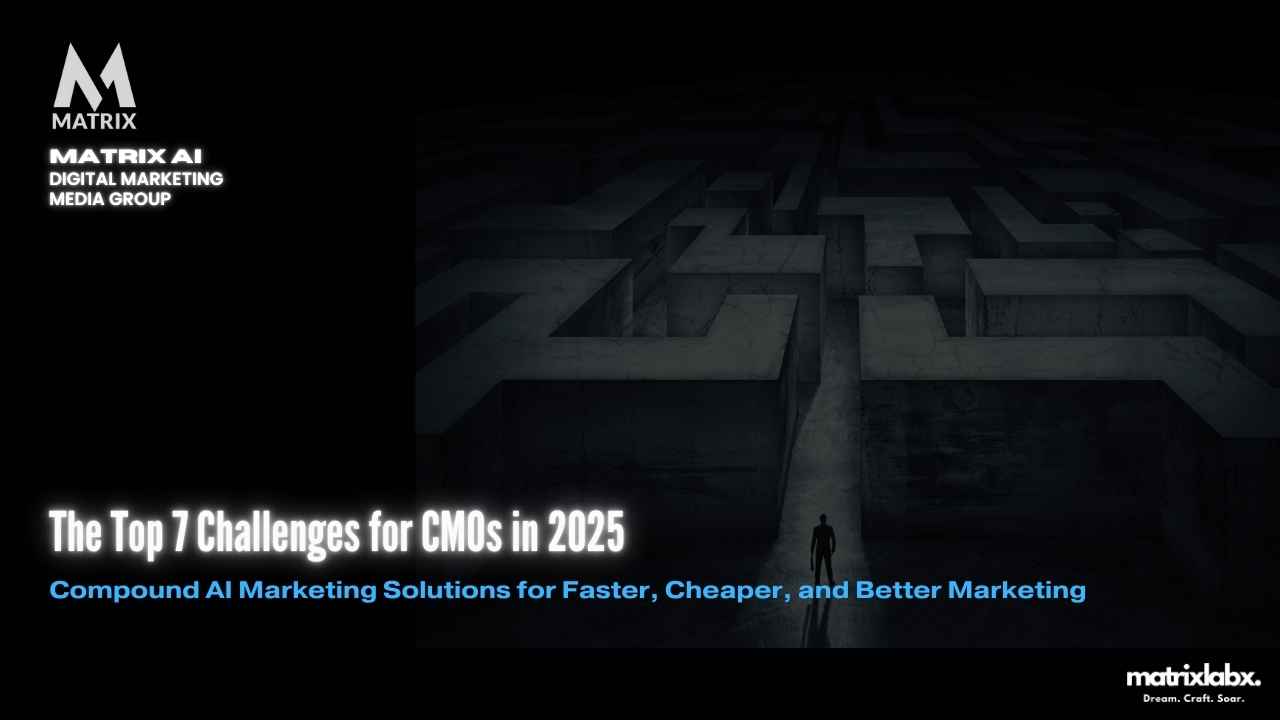The Top 7 Challenges for CMOs in 2025
Learn About The Top 7 Challenges for CMOs in 2025.
Navigating Sales Strategy as a CEO: Key Decisions and Emerging Innovations for 2025
Introduction: Five Major Issues CEOs Will Face in 2025.
As we look ahead to 2025, CEOs are grappling with various challenges that will profoundly impact their ability to lead their organizations effectively.
These challenges are particularly pressing in sales and marketing, which are central to driving growth and securing competitive advantage.
The Top 7 Challenges for CMOs in 2025
As we approach 2025, Chief Marketing Officers (CMOs) face a rapidly evolving marketing landscape shaped by technological advancements, shifting consumer behaviors, and economic pressures.
Success will require strategic foresight, adaptability, and a clear understanding of the critical challenges ahead.
This article explores the top seven challenges CMOs will encounter and how they can address these issues effectively.
We live in a world, a moment in time when AI surpasses human intelligence—an unstoppable cascade of self-improvement begins, and each iteration grows exponentially smarter. This acceleration pushes beyond the limits of your imagination, transforming our world instantly.
We stand on the brink of an unprecedented era when the lines between humans and machines blur into a singularity of unimaginable potential.
For marketers, this isn’t just a glimpse of the future—it’s a new playing field in which the rules of creativity, engagement, and connection are being rewritten.
Are you ready to seize this opportunity and lead your brand into the future?
1. The Integration of AI and Automation in Marketing
Why It’s a Challenge
Artificial Intelligence (AI) and automation are revolutionizing marketing by streamlining processes, enabling hyper-personalization, and delivering predictive insights.
However, integrating these technologies poses challenges related to cost, expertise, and ensuring authenticity in customer interactions. AI Agentic Systems for Marketing Healthcare Organizations
Key Considerations
- Strategic Adoption: CMOs must decide which marketing functions to automate—content generation, customer segmentation, or campaign management.
- Balancing AI and Human Creativity: Automation improves efficiency, but human input is critical for emotional connections and brand storytelling.
- Measuring ROI: Ensuring AI investments deliver measurable performance improvements.
How to Address It
Invest in AI-driven tools like compound marketing agents like those developed by MatrixLabX.
These tools can analyze customer behavior and automate resource allocation, freeing marketing teams to focus on strategic initiatives.
70% of agencies need help integrating AI solutions.
70% of agencies need help integrating AI solutions into their tech stack, citing a lack of interoperability as a major barrier. 85% of marketing agencies need more in-house expertise to manage and deploy multi-AI agent systems effectively.
2. Navigating Budget Constraints
Why It’s a Challenge
Economic uncertainty and the need to maximize ROI force CMOs to achieve more with fewer resources. Allocating budgets wisely across traditional, digital, and experimental channels is more important than ever.
Key Considerations
- Prioritization: Identify high-impact campaigns and allocate resources to channels with proven ROI.
- Efficiency Through Technology: Use AI tools to reduce inefficiencies and optimize spending.
- Data-Driven Decision-Making: Continuously analyze performance metrics to inform budget reallocations.
How to Address It
Adopt technologies like MatrixLabX’s OrchestraAI, a compound marketing agent that analyzes performance data to recommend budget shifts, ensuring resources are directed to the most impactful campaigns.
3. Meeting Evolving Customer Expectations

Why It’s a Challenge
Today’s customers expect seamless, personalized, ethical interactions with brands. Failing to meet these expectations can lead to declining trust and loyalty.
Key Considerations
- Personalization: Customers demand tailored experiences across channels.
- Ethical Practices: Transparency in data usage and alignment with social values are becoming non-negotiable.
- Omnichannel Excellence: Consistency across digital, physical, and social platforms is crucial.
How to Address It: Hyper-Personalization Through AI-Driven Insights
Use AI to gather and analyze customer data, enabling real-time personalization while ensuring compliance with data privacy laws.
Meeting evolving customer expectations is paramount in today’s dynamic market landscape. MatrixLabX’s OrchestraAI offers innovative solutions to address this challenge effectively. Here are two key strategies to leverage OrchestraAI to enhance customer experiences:
OrchestraAI is a “conductor,” harmonizing various AI agents and modules to deliver unified, intelligent responses. This orchestration enables businesses to gain deep insights into individual customer preferences and behaviors, facilitating the creation of highly personalized experiences. AIProdPad Product Development Transformation Through AI-Driven Innovation [White Paper]
Implementation:
- Data Integration: OrchestraAI unifies data across all customer touchpoints, providing a comprehensive view of customer interactions. citeturn0search19
- Behavioral Analysis: Utilize AI algorithms to analyze customer behavior, allowing for tailored product recommendations and personalized marketing messages.
- Dynamic Content Delivery: Deploy AI-generated content that adapts in real-time to meet each customer’s specific needs and preferences.
Enhancing Customer Support with Autonomous AI Agents

OrchestraAI’s Agentic Mesh Framework empowers organizations to leverage autonomous AI agents, optimizing decision-making and operational efficiency. These agents can be deployed to enhance customer support, providing timely and accurate assistance.
Implementation:
- AI-Powered Chatbots: Implement chatbots capable of understanding and resolving customer inquiries, ensuring 24/7 support and quick response times.
- Predictive Assistance: Utilize AI to anticipate customer needs and proactively offer solutions, enhancing the overall customer experience.
- Continuous Learning: Enable AI agents to learn from each interaction, improving their effectiveness and support quality over time.
By integrating OrchestraAI into their operations, businesses can meet and exceed evolving customer expectations, fostering loyalty and driving growth.
For a deeper understanding of how OrchestraAI can revolutionize your marketing strategies.
The Skill Gap: Why 85% of Marketers Are Not Ready
The Skill Gap: Why 85% of Marketers Are Not Ready highlights the urgent need for upskilling in a rapidly evolving digital landscape. Advanced technologies like AI, data analytics, and automation are outpacing traditional marketing expertise, leaving most professionals unprepared to adapt and compete effectively.
4. Retaining and Developing Top Marketing Talent
Why It’s a Challenge
The shift to hybrid work environments has disrupted traditional team dynamics. Attracting, retaining, and empowering top talent requires innovative training, collaboration, and career development approaches.
Key Considerations
- Upskilling: Provide opportunities for employees to learn emerging technologies like AI.
- Engagement: Foster a strong team culture, even in virtual or hybrid settings.
- Leadership Development: Train future leaders to navigate the complexities of modern marketing.
How to Address It
Implement mentorship programs and leverage digital collaboration tools to maintain team cohesion.

5. Leveraging Data While Maintaining Privacy
Why It’s a Challenge
Data is the lifeblood of modern marketing, but stricter privacy regulations like GDPR and CCPA, along with growing consumer concerns, make data collection and usage more challenging.
Key Considerations
- Ethical Data Practices: Transparency in customer data collection, storage, and use.
- Zero-Party Data: Encourage customers to share their preferences through direct engagement willingly.
- Compliance: Stay ahead of evolving privacy laws to avoid legal repercussions.
How to Address It
Invest in secure platforms that handle data ethically and use AI to extract insights without breaching customer trust. Leveraging data while maintaining privacy is a critical challenge for modern marketers, especially as data privacy regulations and consumer concerns grow. Here are two top strategies for achieving this balance effectively:
Implementing Privacy-First Data Collection Practices
Why It’s Important
Consumers are increasingly aware and concerned about how their data is collected and used.
Privacy-first strategies build trust and ensure compliance with data protection regulations like GDPR, CCPA, etc.
Key Tactics
- Zero-Party Data Collection: Encourage customers to willingly share data through direct engagement strategies, such as personalized surveys, loyalty programs, or gated content. This ensures transparency and voluntary participation.
- Transparent Policies: Communicate data usage policies to help customers understand how their information will be used.
- Opt-In Mechanisms: Provide explicit opt-in options for data collection and use, giving customers control over their information.
Example in Action
A retail brand could use a loyalty app to collect customer preferences in exchange for exclusive discounts, ensuring both value for the customer and compliant data collection.
70% of agencies need help integrating AI solutions.
70% of agencies need help integrating AI solutions into their tech stack, citing a lack of interoperability as a major barrier. 85% of marketing agencies need more in-house expertise to manage and deploy multi-AI agent systems effectively.
Leveraging AI for Secure and Ethical Data Management
Why It’s Important
AI-powered tools can process vast amounts of data efficiently, but their use must align with ethical standards and privacy regulations to avoid breaches and mistrust.
Key Tactics
- Data Anonymization: Use AI tools to anonymize data, ensuring that personal identifiers are removed while enabling insights.
- Predictive Analytics: Rely on AI algorithms to analyze trends and customer behaviors without accessing personally identifiable information (PII).
- Regulatory Compliance: Leverage AI solutions that follow global privacy laws, reducing non-compliance risk.
Example in Action
An e-commerce company could use an AI-powered recommendation engine that analyzes anonymized browsing and purchase patterns to deliver personalized product suggestions without directly linking data to individual users.
By adopting privacy-first data collection practices and leveraging AI for ethical data management, organizations can harness the power of data while maintaining customer trust and regulatory compliance.
These strategies mitigate risks and position brands as responsible and transparent industry leaders.
6. Adapting to Emerging Technologies
Why It’s a Challenge
The rapid pace of technological innovation means that CMOs must constantly evaluate and adopt new tools and platforms to stay competitive.
Key Considerations
- Evaluating Trends: Not every new technology will align with business goals.
- Implementation: Seamless integration into existing workflows is critical.
- Future-Proofing: Technologies adopted today must remain relevant as markets evolve.
How to Address It
Adopt scalable solutions like MatrixLabX’s compound marketing agents, which integrate seamlessly into existing systems and provide actionable insights.
Adapting to emerging technologies is essential for staying competitive in the dynamic marketing landscape.
MatrixLabX provides innovative solutions to help organizations seamlessly integrate and leverage new technologies. Here are the top two strategies for adapting to emerging technologies with MatrixLabX:
Leveraging MatrixLabX’s Compound Marketing Agents for Seamless Integration
Why It’s Important
The rapid pace of technological innovation often leads to fragmented systems that can hinder efficiency.
MatrixLabX’s compound marketing agents offer an integrated approach to adopting new technologies, enabling organizations to operate cohesively across various platforms and tools.
Key Tactics
- Unified Ecosystem: Use compound marketing agents to harmonize data, campaigns, and workflows across marketing technologies, eliminating silos and streamlining operations.
- Real-Time Adaptation: These agents analyze real-time data from multiple sources to ensure new technologies are implemented effectively and deliver immediate value.
- Scalability: Organizations can scale their technology adoption by automating integration processes without overburdening their teams.
Example in Action
A retail brand implementing a new AI-driven recommendation engine can use MatrixLabX’s compound marketing agents to integrate the tool with their CRM, e-commerce platform, and analytics systems, ensuring a unified customer experience.
Utilizing MatrixLabX’s OrchestraAI for Continuous Innovation
Why It’s Important
Emerging technologies require constant monitoring, assessment, and iteration to remain relevant and effective. MatrixLabX’s OrchestraAI provides a robust framework for ongoing innovation and agility in adopting new tools.
Key Tactics
- Technology Evaluation: OrchestraAI evaluates the potential impact of new technologies on marketing objectives, helping CMOs prioritize investments.
- Autonomous Decision-Making: AI-driven agents identify opportunities for optimization and recommend enhancements to existing tech stacks.
- Predictive Insights: OrchestraAI uses machine learning to anticipate market trends and customer needs, guiding proactive adoption of relevant technologies.
Example in Action
An organization using OrchestraAI could identify augmented reality (AR) as a tool to enhance customer engagement. The system would assess ROI, predict market adoption rates, and provide actionable insights for seamless implementation.
By leveraging MatrixLabX’s compound marketing agents and OrchestraAI, organizations can adapt to emerging technologies efficiently and strategically.
These tools ensure smooth integration and foster innovation, enabling businesses to stay ahead in an ever-changing technological landscape.
7. Aligning Marketing Strategies with Business Objectives
Why It’s a Challenge
As marketing becomes increasingly data-driven, CMOs must ensure their strategies align closely with overarching business goals. Misalignment can cause wasted resources and missed opportunities.
Key Considerations
- Collaboration: Work closely with CEOs, CFOs, and other executives to align priorities.
- Metrics that Matter: Focus on KPIs directly impacting business outcomes, such as customer lifetime value and revenue growth.
- Agility: Adjust strategies quickly in response to changing business needs.
How to Address It
Use tools that provide real-time data insights to ensure marketing efforts are consistently aligned with business objectives.
Aligning marketing strategies with business objectives ensures that marketing efforts contribute directly to an organization’s growth, profitability, and long-term success.
Matrix Marketing Group offers advanced solutions to help companies achieve this alignment effectively.
Here are the top two strategies for aligning marketing strategies with business objectives using Matrix Marketing Group’s tools and expertise.
Leveraging Data-Driven Insights for Strategic Decision-Making
Why It’s Important
Accurate and actionable data is the foundation of alignment. Matrix Marketing Group provides tools and frameworks to analyze marketing performance and its impact on key business objectives, ensuring that every campaign contributes to the bottom line.
Key Tactics
- Performance Tracking with AI Tools: Use Matrix Marketing Group’s AI-powered analytics to measure how marketing efforts impact revenue, customer acquisition, and other business KPIs.
- Goal-Oriented Campaigns: Align marketing goals (e.g., lead generation, brand awareness) with specific business outcomes, such as market share growth or profitability.
- Real-Time Adjustments: Monitor campaign performance and adjust strategies to align with changing business priorities.
Example in Action
A software company using Matrix Marketing Group’s analytics tools can track the ROI of digital campaigns and adjust targeting or messaging to ensure they align with the company’s quarterly revenue goals.
AI-Agentic System for Content Marketing
AI-Agentic systems like OrchestraAI for content marketing are advanced, autonomous technologies designed to execute content strategies with minimal human intervention.
Integrating Marketing and Sales Through Unified Strategies
Why It’s Important
Disconnected marketing and sales teams lead to inefficiencies and missed opportunities. Matrix Marketing Group helps organizations integrate these functions by aligning messaging, goals, and customer journey strategies.
Key Tactics
- Shared KPIs: Establish metrics that reflect marketing and sales success, such as conversion rates and customer lifetime value (CLV).
- Customer Journey Mapping: Use Matrix Marketing Group’s tools to align marketing and sales strategies throughout the customer journey, ensuring a seamless experience from awareness to purchase.
- Cross-Functional Collaboration: Implement regular collaboration sessions between marketing and sales teams, facilitated by shared platforms and tools.
Example in Action
A B2B organization partners with Matrix Marketing Group to create unified account-based marketing (ABM) strategies that align marketing efforts with the sales team’s target account list, increasing deal closure rates and revenue.
Aligning marketing strategies with business objectives is critical for maximizing ROI and driving business success.
By leveraging Matrix Marketing Group’s data-driven insights and integrated marketing-sales solutions, organizations can ensure that their marketing efforts align with strategic priorities, fostering sustainable growth and competitive advantage.
Conclusion: The CEO’s Path to Sales Excellence
The challenges facing CMOs in 2025 are formidable but possible. By leveraging advanced technologies like compound marketing agents, focusing on personalization and ethical practices, and fostering strong team dynamics, CMOs can effectively navigate these challenges.
The future of marketing will be defined by those who can adapt to change, embrace innovation, and remain steadfast in delivering value to their organizations and customers. With a clear strategy and the right tools, CMOs can transform these challenges into opportunities for growth and leadership.
CEOs’ decisions regarding sales strategy, resource allocation, and performance metrics are critical to their organizations’ success. By leveraging innovative technologies like compound marketing agents from Matrix Marketing Group and MatrixLabX, CEOs can confidently navigate the challenges of 2025.
Integrating these advanced systems into sales and marketing operations enhances efficiency and empowers CEOs to make data-driven decisions that drive sustainable growth. As we move into an era defined by AI and automation, embracing these tools will be essential for staying competitive and meeting the evolving expectations of customers and stakeholders alike.
Google Ads Checklist – Download Now! 🚀
Struggling to get the most out of your Google Ads? 🔥 Download our Google Ads Optimization Checklist and take your campaigns to the next level!
✅ Maximize Clicks & Conversions
✅ Lower Your Cost-Per-Click (CPC)
✅ Improve Ad Quality Scores
✅ Target the Right Audience
This free checklist will help you set up, optimize, and scale your Google Ads campaigns for maximum ROI.


